Amy Q. Barker's Blog, page 2
July 30, 2021
Rue: One Year Later

First, let me say thank you to everyone who has supported me and my writing journey--it’s been a wild and crazy ride!
Second, I've learned so much in the past year--mostly gratitude for everyone who has been so kind as I have "put myself out there" for all to see, hear, and read. It's a VERY scary thing to write, publish, and promote a book! Although the characters and stories are fiction, they all have a piece of me laced into every word, thought, and feeling. I'm so grateful! With this latest third book I'm about to publish, I feel much less nervous/anxious to launch and that is a direct result of your support and understanding of me following my dream. Thank you!
Third, a year in and I’m amazed, humbled, and grateful to still be receiving great reviews every day like this one for Rue and this one for Punk, both from the other day.
Fourth, on this one-year anniversary of publishing Rue, my debut novel, I decided to take a trip down memory lane to see where it all began - From My Diary:
11/3/2016:
Book idea (Rue):
Story of Saturday Morning Bird Hikes – from my time at Cool Creek Park, with the old guys and their “soft ball” songs and how someone (a lounge singer?) learned songs from the 40s from them. Story of San Francisco – a piano player at night in the Scarlet Huntington. What does she do during the day? Does she have another job? How does she know all of these songs in her head? Photographic memory? From the bird hikes? What is her life like that’s she able to play like this at night in this location? Where does she live? Must be a hovel in China Town, to be able to afford.Coincidentally, on this same day, I also wrote this in my diary, which would later become the book idea for Punk:
Story of Grandma Q – growing up in Rochester, working at McCurdy’s, the courtship with Paul before she married Grandpa. A guy who falls off the face of the earth right before the wedding, and the diary ends abruptly with no explanation.Back to Rue:
11/25/2016:
Started a new book today from my idea the other week. Not sure where it’ll go, but I couldn’t keep myself from starting it. It had to be written, like a force leading me forward.
11/27/2016:
Watching TCM this morning. Daisy Kenyon—I’d never even heard of this movie before, but it was great, with Henry Fonda, Joan Crawford, and Dana Andrews. It’s about a love triangle and I wonder if I might put a book together about a love square instead of a love triangle. I have been thinking how to make this story also be about polar opposites—a person who is quiet, shy, small who falls in love with a tall, loud, popular type. I don’t know his name yet, but hers will be Rue, tiny and quaint, but packs a punch.
12/9/2016:
Things have been slow-going on the book. I’m still trying to find my voice for Rue. She’s so different than me and from anything I’ve ever written. This one’s going to have to ruminate longer, so I let things pop in naturally, at the proper time.
12/12/2016:
Woke up the other night realizing Rue’s story might have a tentative title of The Scarlet Rue because she’s a lounge singer at the Scarlet Huntington in San Francisco. Or maybe just plain Rue. I had an epiphany the other day: I thought I would do the whole thing from Rue’s perspective and call it Rue, but then I realized maybe I would tell the story from the four character’s points of view instead. I got a little sad, though, wondering if I would lose Rue in the mix, so maybe instead Rue will be the main focus of the story and almost everything will be about her thoughts and feelings, but I’m going to put in a few chapters where she’s on the periphery. I don’t know if it’ll work…we’ll see…
12/19/2016:
Making good but slow progress. Almost done with Chapter 2. I can only write what I know and what I feel. Shouldn’t readers out there be inspired about real-life characters and how they survive struggles? Such a difficult balance to manage though.
1/3/2017:
Wow, it’s 2017 already. Wasn’t the best week of writing…not enough time or motivation. It’s all still floating around in my head. Something about Josh being from a big family, youngest boy of 6, let’s say, has to have all of the attention, exact opposite of Rue. He wants to be seen from all angles at all times. Rue wants not to be seen in plain sight. I also thought about figuring out a character who is “blissfully oblivious”– like someone who has no tact and has that overinflated sense of self but can’t see past her nose—thinking it’ll be the other girl in this love square (Alyssa). On a different note, I want to speak to the fact that there are so few novels for woman my age that have drama without trauma. That’s the space I want to fill. Why does everything have to be about rape and violence and horrible people? I hope to change that.
1/20/2017:
Wow, I haven’t written here in a while. But I have been writing Rue every day, so that’s why. I think I’m at about 28,000 words now. It’s going well. The other day, while driving in the car, I realized I have been writing almost every day now for 7 months. EVERY DAY! I went from thinking about writing a book since I was 12 YEARS OLD and never doing it to now writing every day and making progress on TWO books. Crazy. I’m proud of myself. Even though no one else has read a word or even knows I’m writing. I’m still glad I did it. I have more to go. Miles to go before I sleep, as Frost says.
2/26/2017:
I’m about 62,000 words into Rue now. Going well, but difficult to write because (1) not at all about me – actually, exact opposite of me (2) scary not knowing if I'm a good writer or not (3) reading other books and going to bookstores makes me want to die now – something that used to be my salvation and joy – is so, SO painful now – like a weight around my neck – how to keep writing when there are so many other books out there and probably all better than mine (4) what the hell am I doing anyway? what makes me think I can be a writer? Anyway, regardless, Rue's still coming along, even when I have bad days and thoughts. So, the reason I’m writing here again in this diary after nearly 2 months is because Bobbi is unexpectedly coming to Indy for work and I’m thinking about telling her my secret and giving her a copy of my book. I’m paralyzed with anxiety about it. What if she hates it? What if she tells me to never show this to another living soul? What if she thinks it’s the worst piece of drivel she’s ever read? I’ve written down a bunch of caveats to give her with the book, but still…I’m afraid, very afraid. Lord, give me the strength to go through with it!
Note: Despite my fears and anxiety, my friend Bobbi (God bless her and rest her soul!) told me to keep going, so I did. Skip ahead and I finished writing Rue on 5/2/2017. Then, months later, this entry:
2/18/2018:
Rue is done, but lately, every day, I’ve been having this thought: I must turn Rue into something different. The same general plot, but she is blind! It’s been driving me crazy, and I can’t seem to get it out of my head: Rue must be blind. I can’t explain it, but I must give it another try with Rue being blind.
Note: Believe it or not, I spent the next YEAR rewriting Rue as a blind character, completing hours of research to know what it meant to live independently in a big city as someone who is blind. It was just about the most difficult thing I’ve ever done and I’m so proud of myself for creating such a rich, captivating, empathetic character--readers really seem to connect with her. Maybe someday I'll write a sequel to Rue, but for now, I'm working through the massive backlog in my head of new, original story ideas about other characters, people, places, and adventures.
So, that was just a snapshot of my writing process and a year after publishing Rue, I'm happy and humbled to still be following my dream AND to be a few weeks away from publishing my THIRD book – WOOT! WOOT!
Thank you all again for your amazing support!
Love,
Amy
July 10, 2021
Digital Detox and Channeling my Inner Gene Stratton-Porter
I’ve been on vacation this week and so I decided to stay off social media as a form of digital detox, to let my brain, mind, body, soul, spirit have a restart without technology.
I have to say, it felt wonderful! I hiked every day, visited three Indiana State Historic Sites, met several newfound kindred spirits, finished the final edits on my new book (YES!), and spent the week cherishing friends, family, food, love, and life. I couldn’t have asked for a better week.
Below, I’ve provided some of the highlights. I hope you enjoy sharing my journey!
Forgive the length of this blog, but I wanted to include images and notes together.
7/3/2021: Spring Mill State Park

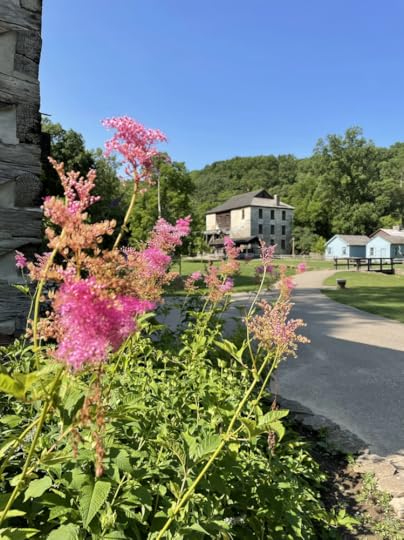
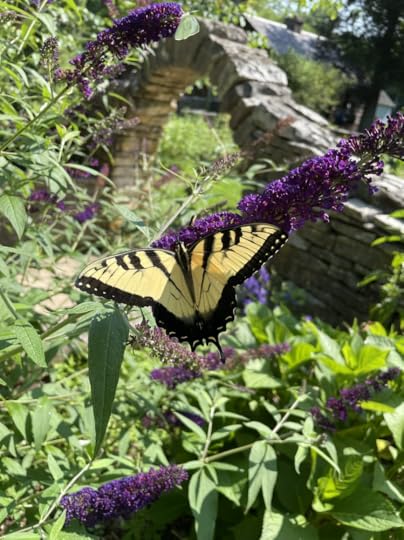 https://video.wixstatic.com/video/40eae5_fb95753fd9b241d4be1b1341499c0f25/480p/mp4/file.mp4
https://video.wixstatic.com/video/40eae5_fb95753fd9b241d4be1b1341499c0f25/480p/mp4/file.mp4· Pioneer Village in the middle of nowhere, that has been there since the 1800s.
· Huge working Grist Mill.
· Restored buildings with period pieces.
· Workers in the buildings doing the actual trade from that time—weaver, tanner, blacksmith.
· Also, schoolhouse, garden, tavern, spring house, meeting house, apothecary, mercantile, museum, nature center, State Park Inn.
· Beautiful hiking trails with option to visit/explore caves.
· What I loved: the smell of the buildings—real wood fireplaces, old wooden floors, the herbs, spices, candles, tallow, the quilts, the things on the walls and in the rooms, furniture, etc. all very authentic and special.
· The inn is nice too—bought a wood block from the little crafting and quilt store, and a T-shirt that says Stay Wild.
7/4/2021: Morgan Monroe State Forest – Low Gap Trail
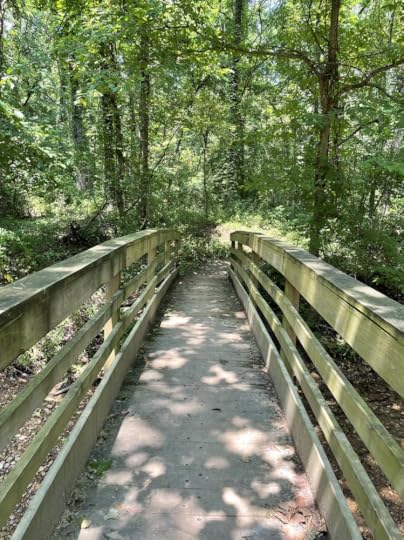
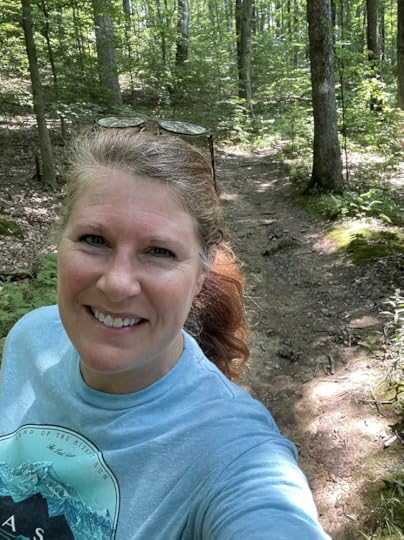
· Remember when your parents used to tell you that they used to have to walk two miles to school and both directions were up hill? Well, this trail felt like that—up hill both ways! Very steep, both directions.
· Thickly wooded trail with a lot of ferns and woodpeckers and birds off in the distance.
· Was rather muddy and buggy.
· Only saw one other person in an hour. Very desolate. Perfect for writers trying to work out something in one of their stories (like me!).
7/5/2021: Clifty Falls State Park
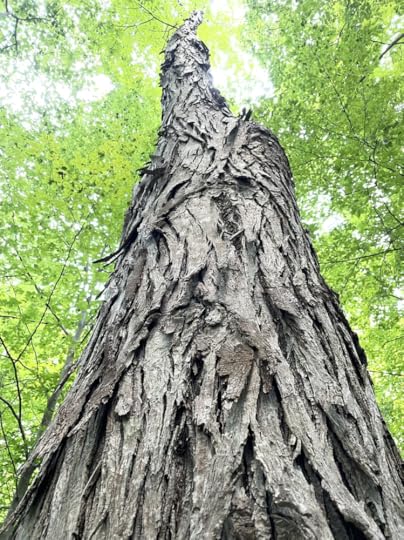

· Very rugged trails, which I love. What does very rugged mean—a LOT of tree roots and stumps on the trail, very steep hill climbs, walking along a creek bed that is filled with a thousand misshaped stones, some slippery, TONS of cobwebs, easy to get lost, trails not very well marked or defined.
· Sad that it was so dry, the falls weren’t much to look at.
· Saw a belted kingfisher, a pileated woodpecker, and a lot of fish.
· I was SO tired after hiking up and down the mountainside two-three times and then getting lost and walking the rest of the way back via the road to get to my car. I had a LONG nap when I got home.
7/6/2021: McCormick’s Creek State Park
https://video.wixstatic.com/video/40eae5_9aa7402283a14861b68687a3db6c2a3c/480p/mp4/file.mp4· Falls were flowing, but it was busy down on the creek, so instead hiked a path deep in the woods, trail 9, which I loved and would do again in a heartbeat, no ONE else was out there.
· Heard many beautiful songbirds, so thankfully not all of them have perished from the new unknown fungal disease we've been hearing about.
· Saw a flock of crows ganging up on a hawk in the woods.
· Ate at the Inn, which has wonderful salads with the best salad dressing., dove into my current read, Patricia Sands' The Promise of Provence.
7/7/2021: Cabin at Wildflower Woods (Gene Stratton-Porter Historic Home in Rome City, IN)

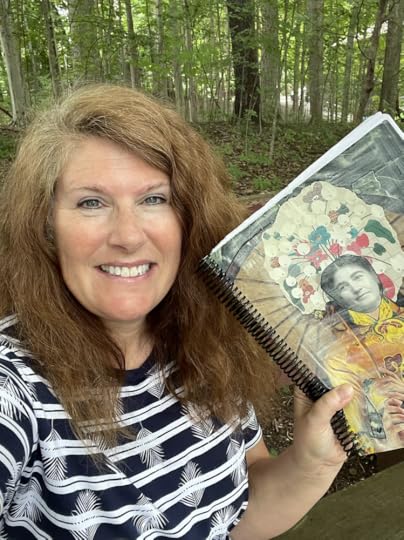

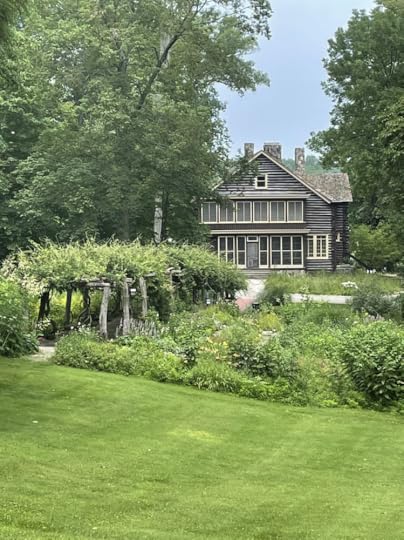
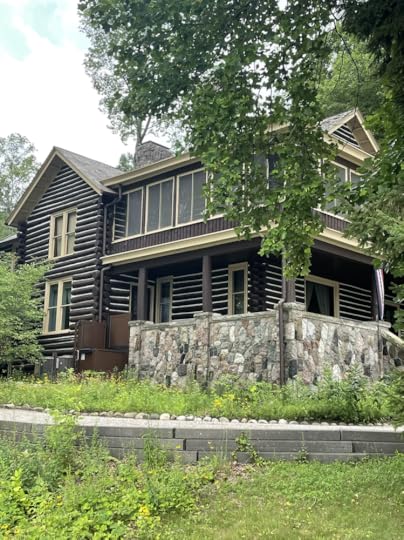
 https://video.wixstatic.com/video/40eae5_70d98046635848fc88550f45537c68dc/480p/mp4/file.mp4https://video.wixstatic.com/video/40eae5_25f9fe7ede544e1ea7e605082f01ba91/480p/mp4/file.mp4
https://video.wixstatic.com/video/40eae5_70d98046635848fc88550f45537c68dc/480p/mp4/file.mp4https://video.wixstatic.com/video/40eae5_25f9fe7ede544e1ea7e605082f01ba91/480p/mp4/file.mp4First—if you don’t know who Gene Stratton-Porter is, please check out her Wiki—she was an amazing author and person! She sold 50 million copies of her books in her time—50 MILLION!
https://en.wikipedia.org/wiki/Gene_Stratton-Porter
One little teaser from her Wiki:
Of the fifty-five books selling one million or more copies between 1895 and 1945, five of them were novels written by Stratton-Porter. Among Stratton-Porter's best-selling novels were ,Freckles (1904), ,A Girl of the Limberlost (1909), The Harvester (1911), Laddie (1913), and ,Michael O'Halloran (1915).
My notes on the day:
· BEST day ever BY FAR.
· All because of my INSTANT connection with my tour guide, Sarah, for the Gene Stratton-Porter house.
· She was amazing and it was an all-around “kindred spirit” day on about 50 fronts.
· First, let me talk about the house; spectacular with amazing black cherry covering the walls of the entrance way, then opening into a bright, airy dining room with a fireplace, followed by built-in bookcases galore, desk office area with beautiful window overlooking East side of the house, screened-in porch overlooking amazing garden.
· I loved the fireplace, made out of some type of local composite stone material that is natural to the area.
· Also, her photographs scattered throughout the house, which are of moths/butterflies, but also herself and her daughter and husband.
· I asked Sarah if the descendants went on to have kids and she said yes, there are still great-great-granddaughters around and one is coming to visit on Tuesday! I was sad to miss her. Sarah said she wasn’t working that day, so would miss her too. I wondered what the granddaughter would think about strangers traipsing through the house. Sarah told me that one of the reasons that Gene moved to California is because people used to try to come onto the property to get a glimpse of her (which is crazy because this place is in the middle of NOWHERE), but then again, here I was, making an entire day trip (3.5 hours) to get to her home and spend the day drinking in her ambiance and juju, so I guess I understand!
· The other things I loved: the frogs in the pond, who all jumped away from me, except one who stared at me with his froggy dagger eyes. The amazing views of the lake from different benches strategically placed along the shore, the rain that fell on us and I didn’t care because it was still beautiful and I could imagine Gene sitting in the rain, drinking in her surroundings for inspiration.
· The fact that The Harvester (my favorite book by her) was written about the lake before she even built her house there—I believe she must have had a premonition about it being her future home and how much it would come to mean to her and had to write a book about it.
· During the break between the house tour and the grounds tour, Sarah allowed me to sit with a super-secret notebook which contained copies of Gene’s actual handwritten field and nature notes combined with instructional information about writing. I really felt such a connection with Gene as I sat on her bench and read through (and absorbed into my pores!) every ounce of her.
· The grounds and garden tour with Sarah was awesome—it rained, but we had umbrellas and I didn’t care. The wisteria over the trestle was extensive and the most magnificent I have ever seen. The gardener does a wonderful job keeping up the native flower beds that Gene herself tended to and loved so much.
· One little tidbit—Sarah told me the stalks of jewel weed, which were blooming, are a natural antidote to stinging nettles! I wish I had known that a few days before at Clifty Falls, when I got a stab of them in my leg. I felt the burn for the next hour, and then poof, it was gone.
· We stood next to Gene (and her daughter Jeannette’s) gravesite, which Gene had requested be placed next to this huge lone-wolf Chinkapin Oak and Sarah read a script out of The Harvester where a character was purposely buried on this spot because of its loveliness and because the “fingers of the roots” would reach out and protect them and this site of beauty.
· I loved all of the stories about Gene—how she was revolutionary for her time—she wore pants and took nature photographs and supported a staff of people. Everything about her was inspiring.
· She had several live-in employees (7 bedrooms upstairs!), including a secretary who typed her works, a gardener, a chef, housekeeper, etc.
· She had funny names for her daughter/granddaughters, including one granddaughter called Morning Face, so I sat on the bench with her name and smiled to myself, thinking about how whimsical Gene was and how I will always try to be that way with my grandbabies.
· Even though Gene contracted the Spanish Flu and apparently had to move to California for her health (then sadly got hit by a trolley and died before she ever had a chance to live in the huge mansion she built in Bell-Air), I am so thankful that the state of Indiana has been able to restore and maintain this house that has such deep meaning for me and for so many others.
· At the end of the tour, I didn’t want to leave, so I walked around the grounds for a while longer, drinking in the feel of the woods and Gene’s presence with me.
· It was a magical day.
7/8/2021: Limberlost State Historic Site, Geneva, IN
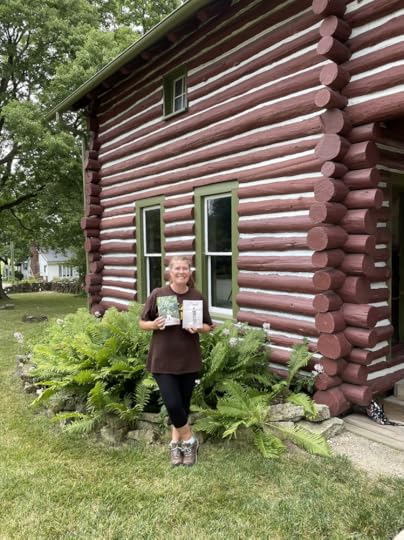

 https://video.wixstatic.com/video/40eae5_81021f51bd994f45b7afe2b9365c941f/480p/mp4/file.mp4
https://video.wixstatic.com/video/40eae5_81021f51bd994f45b7afe2b9365c941f/480p/mp4/file.mp4· Started the day by hiking in the rain through the wetlands—saw many birds and thought Gene would be so proud that the wetlands that had been so decimated in her lifetime were being brought back to life.
· At the house, tour guide, Curt, was very thorough—he talked for 2.5 hours! I have no idea how he memorized all that information.
· Three others on the tour with me—two nice students from Ball State—one from Sri Lanka and one from Jordan, and their professor. We were ALL so impressed with the accomplishments of the author—what she did in her lifetime, starting right in this tiny town in central Indiana, in this cabin surrounded by a swamp.
· Beautiful woodwork throughout the house—on the walls, on the floors, on the moldings.
· Also on the walls, these decorative moldings that are original and made of a product I never heard of (Lincrusta). Very delicate and beautiful.
· SO many photographs—of herself and her family and wildlife
· She was a spectacular illustrator, painter, musician, naturalist, artist—all around very talented.
· Wove in TONS of references/people from real life into her stories.
7/9/2021: T.C. Steele State Historic Site (House Museum) in Brown County, IN
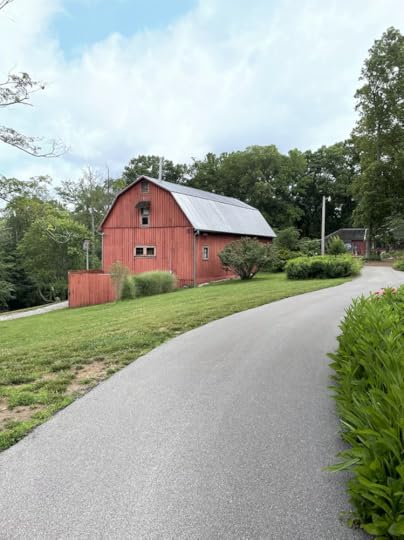

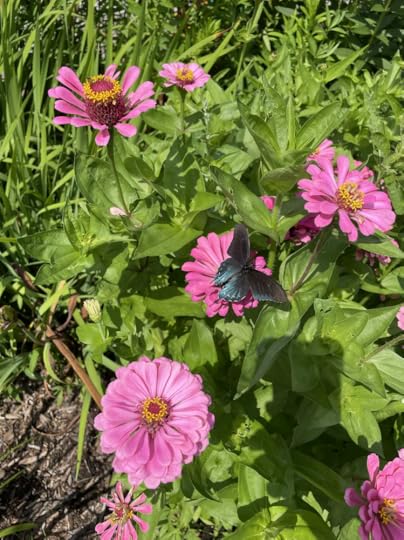


https://en.wikipedia.org/wiki/T._C._Steele
· T.C. Steele was a landscape and portrait artist from early 1900s. His paintings are rare and sell for about a quarter million dollars today (when they come up for sale, which is almost never).
· Beautiful grounds—200 acres on a hill overlooking a huge, wooded valley, including formal garden.
· Surrounded by a forest of mature trees of every variety, but several Oaks in the front yard are still standing and were reflected in his artwork from 1907.
· All original furniture, books, decorations (including hand-stenciled curtains and cupboards by T.C.’s wife, Selma).
· Studio tour very relaxing—to sit and absorb the works in a quiet, peaceful setting with overview from tour guide, I just loved it.
· Two older gentlemen from Seymour, IN were on the tour with me. They had a lot of questions which made the tour very interactive.
Hope you have enjoyed my digital detox week of rest, enrichment, and reset.
Love,
Amy
June 15, 2021
Dreams really can come true!
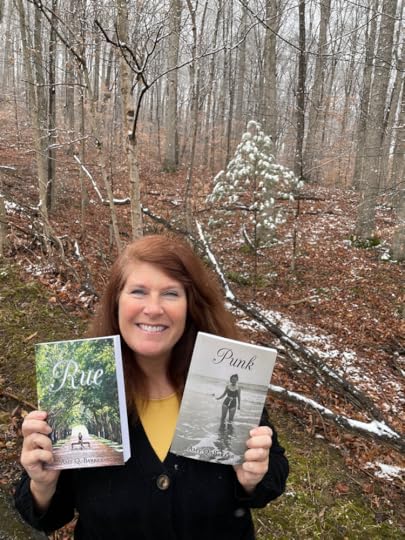
Five years of writing! That’s a long time. In fact, it’s 1,826 days of writing. Wow, I’m tired. But I wouldn’t change a thing. Not the ups. Not the downs. Not anything.
Ups:
The love and support of friends and family—people who believed in me before I believed in myself. Leaving a piece of me here on earth that has its own life and will go on, even after I’m gone (which I hope won’t be any time soon!). Having a dream and making it happen, despite the obstacles. Finding a whole new community of like-minded readers, writers, and friends. Finally having an outlet for my crazy, overactive imagination. Reading the reviews of strangers, saying they like my books. Meeting my editor, Kira Freed, who knew exactly what to say and what to do to make me a better writer and to make my books shine. That I am privileged and blessed to do what I love. Writing every word. Every single word is mine and came from me, and no one else. I did that. These books—they are my babies.Downs:
The years it took me to have enough confidence to start writing. The years after that where I wrote and wrote and wrote, and nothing I wrote was very good. The years of querying agents and receiving rejections. The days when I would rather lay down and die than write another word. The days when I wonder if I’m just a fool thinking I know what I’m doing. The days when I see another writer is successful and I’m still struggling. The days when no one gets me or what I’m trying to achieve. The moments of sadness, fear, anxiety, hopelessness. The moments of “putting myself out there” only to be ignored or rejected. The moments of loneliness when I feel like I’m on an island. The moments when I want to quit because it’s too hard, too painful, too much.What I’ve learned:
Writing is like a muscle that needs to be exercised, stretched, and pushed to make it work properly and with the best results. Writing is hard. Writing is exhausting, exhilarating, exciting. Writing is what I am meant to do. Writing is my child, my pet, my hobby, my vocation. Writing is my therapy. Writing is my life.What is your dream? How will you make it come true?
P.S. Funny story: Recently one of my grandbabies noticed Punk on my bookshelf and asked if I had “put another book together” (meaning wrote and publishing another book). I said, “Yes, I did!” She went home and asked her parents, “Did you know Nana has two books?” When they said yes, they knew, she proceeded to tell them, “You know, Nana can put books together and fold knives and forks and spoons inside of napkins!” Apparently, at some point I must have mentioned that I used to be a waitress (30 years ago!) and that I knew how to prep the silverware/napkins, and she thought how writing a book was just as impressive as that!
January 22, 2021
Punk: News from the Great Beyond
Was it just a break-up?
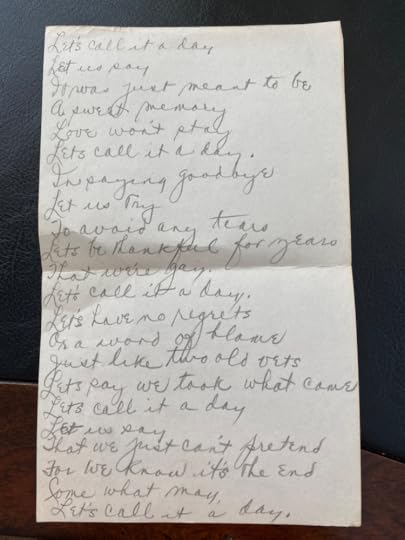
After I published Punk, my aunt went digging into my grandmother's documents. She found a bunch of poems and other writings that seem to imply that grandma and Paul broke-up. If that is true, then it solves the mystery and makes me feel sad for her, but not as sad as the devastating fate I imagined in Punk for both of them.
Still, to be twenty and in love and to think (with all your heart) that you are going to marry someone, and then to have it all fall apart. It must have been horrible. Reading her poems (like the photo above), I feel like she was somewhat resigned to the fact that it wasn't going to work out, but I'm sure it was still difficult to face that reality. In the 30s, I think it was quite common (and rather expected) that you meet, fall in love, and marry very young, if for no other reason than to reduce the family's financial burden. In Punk, I describe the straps that Paul was in, and his family--this is true of the real Paul as well, according to my grandmother's diary. I believe some of the reason it didn't work out with them was because they didn't have the means to move forward and be together as an independent married couple. To that point, here is another poem my aunt found, written in my grandmother's hand, but clearly describing Paul's sentiments:
So Broke
So broke, so broke
But happy at times
In love, in love
We could be happier with dimes
I want you for my very own
To wed and call you mine alone
But I want to be able to take care of you
To give you everything fine and new
Oh, I'm so broke!
May heaven help me find a way
To earn a living someday
I'm willing to work at any old thing
Just for the money and happiness it will bring
I love you and I vow
I will wed you somehow
Though I'm so broke right now
My aunt hasn't uncovered any information between 1933 and a few years later when grandma met my grandpa, so that time period is still a mystery. I imagine she was grieving the loss of Paul and the love they shared. I wonder if Paul was still part of her friend group and how uncomfortable that must have been. I also wonder if her break-up had any influence on her ultimately meeting and marrying my grandpa. Was she totally over Paul by then? Was she afraid to fall in love again? What was she up to during this period? Was she feeling pressure to get married because she was older? And I wonder, what ever happened to Paul? Did he end up marrying someone else? Did he move back to PA?
I guess there are some things we'll never know. One thing I do know, though, is that my grandma and grandpa went on to have a long and happy marriage together (despite grandma's earlier heartache with Paul, or maybe because of it). Life is like that sometimes, isn't it? A heartbreak that teaches us what isn't going to bring us happiness, so that we know how to find it, grasp it, and cherish it when it does come along.
January 8, 2021
Punk: What is Real and What is Not
Yep, that's my real grandmother: Vavavoom!
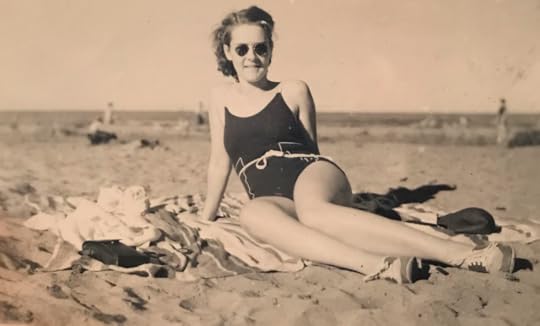
Isn't she spectacular? I think this photo was taken the same day as Punk's cover (on the Manitou Beach with Paul). I love her suit and shoes and sunglasses. And those legs--wow!
I've had several of you ask me what is real about Punk (and Rue) and what is not.
Disclaimer #1: Both novels are works of fiction. Period. I made up everything and wrote every word myself.
Disclaimer #2: There are some spoilers below, so please don’t read this blog until you have finished reading both books.
Okay, now that I’ve gotten that out of the way, let me decipher the truth from fiction:
Punk:
I was inspired to write Punk after reading my grandmother’s 1932 diary. My aunt loaned me the diary about 6 or 7 years ago and after reading it, I was fascinated and intrigued by it. I never forgot it. Much like Didi’s diary, my grandmother’s diary ends abruptly with no explanation. Also like Didi, my grandmother spent the entire course of the diary talking about her love interest, Paul, who was not my grandfather. The photo on the cover of Punk is my real grandmother, who grew up in Rochester working the “books” at McCurdy’s. Like Didi, she was feisty, smart, resourceful, and sociable. My grandmother’s story is still a mystery to me. From the time when her diary ends until she marries my grandfather 5 years later, I have no idea what happened to her or to Paul. The real Paul’s name is Paul Meyer or Paul Myer (not Paul Miller). He was born January 14th, 1914 and was from Sonestown, PA before he moved to Rochester. He had at least two brothers (Bunoso/Burrows and Clay). His father was dead by the time he moved and started working at the “stand” with his brothers and mother. Maybe Punk will shed some light on who he was and any other missing pieces. Unlike Punk, I don't believe Paul died. I do believe that possibly my grandmother and Paul simply broke-up, but I have no evidence of this or anything else. I have asked my dad and aunt about the “missing years” and they know no more than me. They are familiar with some of the names in the diary (the other friends and family), but they don’t know how these people fit into my grandmother’s story during the time before my grandfather. Update: See new blog post "Punk: News From the Great Beyond." FYI—many of the activities and words used in Didi’s diary are directly out of my grandmother’s diary from 1932. So before you think Punk is littered with typos, know that every word and expression has been carefully researched and is not an error or by accident! This includes: the movie theaters where she sees "shows," going bowling, playing ping-pong, attending a watermelon party, gargling with kerosene, riding the streetcar, participating in Young People's Meetings, etc. I have also included her fascinating word choices such as “on the morrow,” “washing my head,” “crapehanger,” and "hamburg roast." Also, check out this real photo of the Elmheart , where they held the dance marathon. For more Rochester nostalgia, here is a link that inspired me while I was writing Punk. I was tasked with cleaning out the attic of my own family home when I was seventeen (not as punishment, but as a paid chore) by my mother and I found (and kept) many of the items I mention in Punk, including the cherry music stand, the yellow depression glass bowl, and the Kodak camera (all of which I will post to my social media accounts soon, so you can see what I still see in these innocuous items--that there is magic attached to them, as there is magic attached to my grandmother's diary).Here is where the truth verges off into fiction:
There is no real D.D. There was no incident, but I fear something like this for kids living in the digital age today and how quickly a rash decision can change a life (or many lives) indefinitely and irrevocably. Delia and Heather are entirely made up. Although I would like to say (you may have already guessed) that Delia may or may not be born out of my own inner rebellious teenager (but I cannot confirm or deny this). Grandpa Ron in Punk is not based on my real grandfather who was a wild, gregarious, funny man and not at all like Grandpa Ron. Some aspects of Heather and Aunt Mary’s early lives were loosely based on my own mother’s unsettled and chaotic childhood, but for the most part, I have fictionalized this storyline in Punk. I personally played soccer for 43 years, but I was (sadly) never as good as Delia. Jake, McKenzie, Donna, Christine, Tanya and all of the other characters mentioned are not real.One last note on my grandmother: She's been gone for thirty years now, but I really felt her presence with me as I wrote this novel. When I was young, I remember her being a kind, organized, caring grandmother. As I grew older, what I remember most (sadly, as with Didi) was her slowly falling prey to that devastating and insidious disease, Alzheimer's. It was like a long, agonizing goodbye that robbed her not only of her memory, but also of her dignity and in a way, the very essence of who she was. My tribute to her is this book, which brings her back to life, creating a new memory of her and for her, one where she is young and hopeful and her life is still filled with possibilities.
Rue:
I was inspired to write Rue after visiting San Francisco. My husband went to a work conference there every year for many years and I would take a week of vacation and tag along. While he was at class, I would go out exploring. Over the years, I began to feel the heart of the city pulsing in my veins, to the point where I couldn’t get it out of my head. I had the map of every street, every restaurant, every shop, every bakery, every museum, every park trail, every thing memorized, and I couldn’t let it go. I felt like the city had become a part of me. One year we stayed at the Scarlet Huntington. It had just been remodeled and I distinctly remember sitting on the balcony, overlooking the city, and a hummingbird came to land on a potted flower right next to my feet. I said to myself, this is the feeling I would like to capture in a story—this magical, mystical, authentic feeling of the city of San Francisco. That same night, we were sipping drinks in the Big 4 lounge, and a piano player came in and entertained the guests. Lightning struck! Lounge singers had been part of America’s culture for years and yet, sadly, they were rather a dying breed, weren’t they? Wouldn’t it be amazing to capture this moment (a lounge singer enchanting a roomful of people in one of the most magical cities in the world) and memorialize that feeling for all time in a book? Thus was born the idea for Rue. I have personally spent time at all of the locations mentioned in Rue. Everything else in Rue is taken directly out of my overactive imagination, including Rue and Josh and Kevin and Alyssa, and all of the other characters and their stories. For more information on why Rue is blind, check out my other blog on the topic.Drama Without Trauma
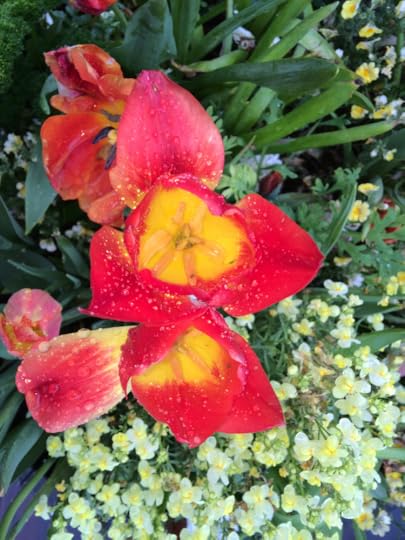
Hello my faithful readers:
I wanted to give you a flavor of what my writing is all about and more importantly, what it's NOT about:
So, if you’re looking for an author that writes gore, violence, rape, murder, incest, crime, dismemberment, monsters, bloodletting, grossness, hate, or evil, then I’m not the author for you.
If you’re looking for an author that writes strong, fierce, independent women who tackle their life issues with the help of conviction, family, friendship, sarcasm, resilience, grace, wisdom, and candor, then come on inside.
Welcome to my world. Enjoy the view. Put your feet up. You’re going to want to stay awhile.
When I write my stories, I’m all about romance and love and heartache and renewal, but I’m also about honesty and pain and justice. This isn’t a cookie-cutter Hallmark movie. I’m going to throw in some stuff that feels uncomfortable and thought-provoking, like abject loneliness and undeserving betrayal.
But I promise you, in the end, you will feel fulfilled, satisfied, and happy (or at least like you went on a wild, wonderful ride that left you wanting more).
Love always,
Amy
Why is Rue blind?

First let me say that I am not visually impaired or blind and I don't have a personal relationship with anyone who is. I certainly don't want to imply that I know what it's like to be blind or to speak on behalf of people who are blind. Rue is fiction and came completely out of my head and my own imagining of what it would be like to be blind. Therefore, you may ask, why would I make Rue blind?
The short answer is this: I don't know. Often my characters come to me fully fledged and I'm simply trying to keep up with their actions by typing them as fast as I can. When I first started writing, I was completely fascinated by this! Where does inspiration come from? I began to pay attention to every new song I heard on the radio, every piece of art I saw, every new recipe, business, blueprint, movie, play, book I came across. Where did it come from? How did the inventor, the creator, the author think of it? Were they just as confounded by it as I was by my writing?
Yes, of course, what I write comes out of my head and there is always a kernel of something I have experienced or witnessed or heard about that has inspired it, but from there it tends to go off on its own mysterious trajectory. Btw, if you're interested in a captivating story of creativity, inspiration, and innovation, check out this Independent Lens.
The idea for Rue came to me on one of my many trips to San Francisco. I have stayed at the Scarlet Huntington and spent many nights sipping drinks in the Big 4 lounge, so that aspect of the story materialized rather quickly and succinctly. However, in all of my earlier versions of Rue, she was sighted. In fact, I spent an entire year writing my first manuscript with Rue as a sighted lounge singer. Then as I finished, I wrote this in my diary: "Lately, I’ve been having this thought: I must turn Rue into something different. The same plot, the same characters, but Rue is blind. She must be blind."
I couldn't explain it and I dreaded it. To re-write an entire manuscript (that was already finished!) about a character who couldn't see? What was I thinking? But there it was, beating a drum in my head every day until I began again. Rue is blind. I spent another year re-writing , carefully removing all references to visual descriptors, including any time Rue "watched" or "saw" or "noticed" or "beheld" or did anything in any way based on vision. Imagine writing an entire story where you can't explain how people are looking at the main character or how the main character sees the world, looks into people's eyes, regards the colors around her, reads a smile or a wink or a frown.
I spent months researching on-line tools, videos, and resources for people who are blind. Finally, I introduced myself (out of the blue!) to a colleague at work who is visually impaired. I peppered him with questions (he was so gracious!). His insightful feedback was enlightening and I made many modifications to Rue based on his advice and input.
Ultimately, my main goal was to show Rue as strong and independent while also showing how she navigates the world in her own unique way. She is resilient and resourceful and beautiful and organized and kind and caring and smart. And yes, she happens to also be blind.



